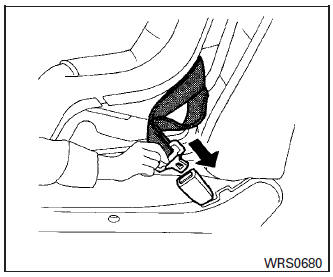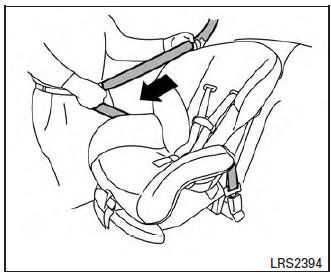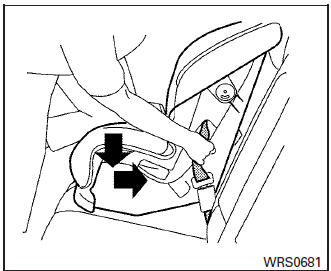Nissan Rogue Owners Manual: Forward-facing child restraint installation using the seat belts
| WARNING The three-point seat belt with Automatic Locking Retractor (ALR) must be used when installing a child restraint. Failure to use the ALR mode will result in the child restraint not being properly secured. The restraint could tip over or be loose and cause injury to a child in a sudden stop or collision. Also, it can change the operation of the front passenger air bag. For additional information, refer to ŌĆ£Front passenger air bag and status lightŌĆØ in this section. |

Forward-facing (front passenger seat) ŌĆō step 1
For additional information, refer to all Warnings and Cautions in the ŌĆ£Child SafetyŌĆØ and ŌĆ£Child RestraintŌĆØ sections before installing a child restraint.
NISSAN does not recommend the use of the lower anchors if the combined weight of the child and the child restraint exceeds 65 lbs (29.5 kg).
If the combined weight of the child and the child restraint is greater than 65 lbs (29.5 kg), use the vehicleŌĆÖs seat belt (not the lower anchors) to install the child restraint. Be sure to follow the child restraint manufacturerŌĆÖs instructions for installation.
Follow these steps to install a forward-facing child restraint using the vehicle seat belt in the rear seats or in the front passenger seat:
- If you must install a child restraint in the front seat, it should be placed in a forward-facing direction only. Move the seat to the rearmost position. Child restraints for infants must be used in the rear-facing direction and, therefore, must not be used in the front seat.
- Position the child restraint on the seat. Always follow the child restraint manufacturerŌĆÖs instructions.
The back of the child restraint should be secured against the vehicle seatback.
If necessary, adjust or remove the head restraint/headrest to obtain the correct child restraint fit. If the head restraint/headrest is removed, store it in a secure place. Be sure to reinstall the head restraint/headrest when the child restraint is removed. For additional information, refer to ŌĆ£Head restraints/headrestsŌĆØ in this section for head restraint/headrest adjustment, removal and installation information.
If the seating position does not have an adjustable head restraint/headrest and it is interfering with the proper child restraint fit, try another seating position or a different child restraint.

Forward-facing ŌĆō step 3
- Route the seat belt tongue through the child restraint and insert it into the buckle until you hear and feel the latch engage. Be sure to follow the child restraint manufacturerŌĆÖs instructions for belt routing.
If the child restraint is equipped with a top tether strap, route the top tether strap and secure the tether strap to the tether anchor point (2nd row installation only). For additional information, refer to ŌĆ£Installing top tether strapŌĆØ in this section. Do not install child restraints that require the use of a top tether strap in seating positions that do not have a top tether anchor.

Forward-facing ŌĆō step 4
- Pull the shoulder belt until the belt is fully extended. At this time, the seat belt retractor is in the ALR mode (child restraint mode). It reverts to ELR mode when the seat belt is fully retracted.

Forward-facing ŌĆō step 5
- Allow the seat belt to retract. Pull up on the shoulder belt to remove any slack in the belt.

Forward-facing ŌĆō step 6
- Remove any additional slack from the seat belt; press downward and rearward firmly in the center of the child restraint with your knee to compress the vehicle seat cushion and seatback while pulling up on the seat belt.
- Tighten the tether strap according to the manufacturerŌĆÖs instructions to remove any slack.

Forward-facing ŌĆō step 8
- After attaching the child restraint, test it before
you place the child in it. Push it from side
to side while holding the child restraint near
the seat belt path. The child restraint should
not move more than 1 inch (25 mm), from
side to side. Try to tug it forward and check
to see if the belt holds the restraint in place.
If the restraint is not secure, tighten the seat belt as necessary, or put the restraint in another seat and test it again. You may need to try a different child restraint. Not all child restraints fit in all types of vehicles.
- Check to make sure the child restraint is properly secured prior to each use. If the seat belt is not locked, repeat steps 2 through 8.

Forward-facing ŌĆō step 10
- If the child restraint is installed in the front
passenger seat, place the ignition switch in
the ON position. The front passenger air bag
status light
 should illuminate.
If this
light is not illuminated refer to ŌĆ£Front passenger
air bag and status lightŌĆØ in this section.
should illuminate.
If this
light is not illuminated refer to ŌĆ£Front passenger
air bag and status lightŌĆØ in this section.Move the child restraint to another seating position. Have the system checked by a NISSAN dealer.
After the child restraint is removed and the seat belt is fully retracted, the ALR mode (child restraint mode) is canceled.

2nd row bench seat
- Top tether strap
- Anchor point
Installing top tether strap
The child restraint top tether strap must be used when installing the child restraint with seat belts.
First, secure the child restraint with the seat belt.
2nd row bench seat
OUTBOARD SEATING POSITIONS
- Remove the head restraint/headrest and store it in a secure place. Be sure to reinstall the head restraint/headrest when the child restraint is removed. For additional information, refer to ŌĆ£Head restraints/headrestsŌĆØ in this section for head restraint/headrest adjustment, removal and installation information.
- Position the top tether strap 1 over the seatback.
- Secure the tether strap to the tether anchor point 2 on the bottom of the seatback behind the child restraint.
- Tighten the tether strap according to the manufacturerŌĆÖs instructions to remove any slack.
CENTER SEATING POSITION
- Remove the head restraint/headrest and store it in a secure place. Be sure to reinstall the head restraint/headrest when the child restraint is removed. For additional information, refer to ŌĆ£Head restraints/headrestsŌĆØ in this section for head restraint/headrest adjustment, removal and installation information.
- Open the top tether anchor 2 cover located on the ceiling.
- Secure the tether strap 1 to the tether anchor point 2 on the ceiling behind the child restraint.
- Tighten the tether strap according to the manufacturerŌĆÖs instructions to remove any slack. Make sure the head restraint/headrest does not contact the top tether strap.
If you have any questions when installing a top tether strap, consult your NISSAN dealer for details.
| WARNING Child restraint anchorages are designed to withstand only those loads imposed by correctly fitted child restraints. Under no circumstances are they to be used to attach adult seat belts, or other items or equipment to the vehicle. Doing so could damage the child restraint anchorages. The child restraint will not be properly installed using the damaged anchorage, and a child could be seriously injured or killed in a collision. |
 Forward-facing child restraint installation
using LATCH
Forward-facing child restraint installation
using LATCH
For additional information, refer to all Warnings
and Cautions in the ŌĆ£Child SafetyŌĆØ and ŌĆ£Child
RestraintsŌĆØ sections before installing a child restraint.
NISSAN does not recommend the use ...
 Booster seats
Booster seats
Precautions on booster seats
WARNINGIf a booster seat and seat belt are not used
properly, the risk of a child being injured in
a sudden stop or collision greatly
increases:
& ...
Other materials:
Ground
Ground Distribution
MAIN HARNESS
ENGINE ROOM HARNESS
ENGINE CONTROL HARNESS
BODY HARNESS
BODY NO. 2 HARNESS
...
Regulatory Information
FCC Regulatory information
CAUTION: To maintain compliance with
FCCŌĆÖs RF exposure guidelines, use only the
supplied antenna. Unauthorized antenna,
modification, or attachments could damage
the transmitter and may violate FCC regulations.
Operation is subject to the follow ...
C1101, C1102, C1103, C1104 wheel sensor
DTC Logic
DTC DETECTION LOGIC
DTC
Display Item
Malfunction detected condition
Possible causes
C1101
RR RH SENSOR-1
When power supply voltage of rear wheel sensor
RH is low.
When an open or shorted circuit is detected in rear
wheel sensor RH ...
